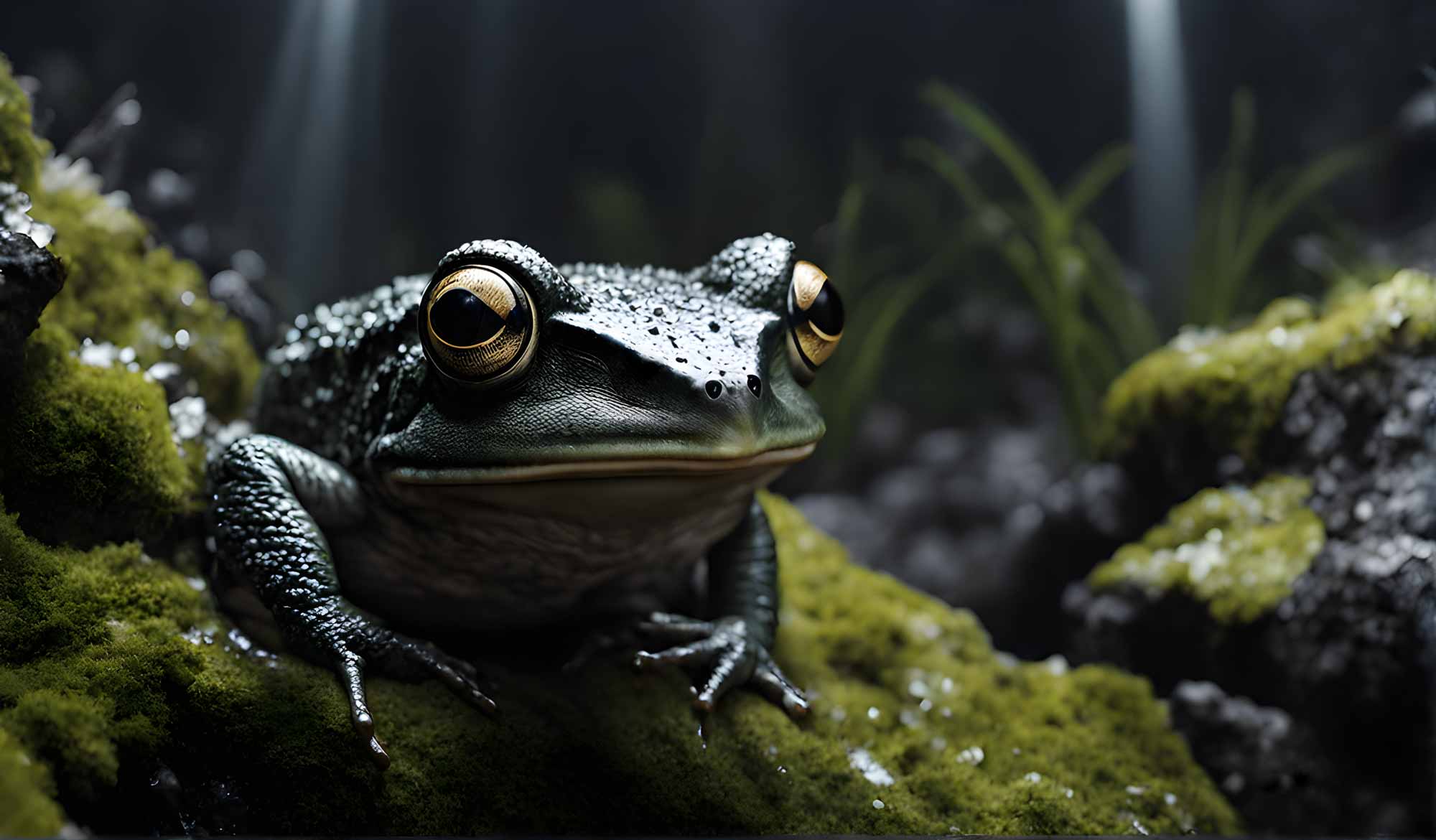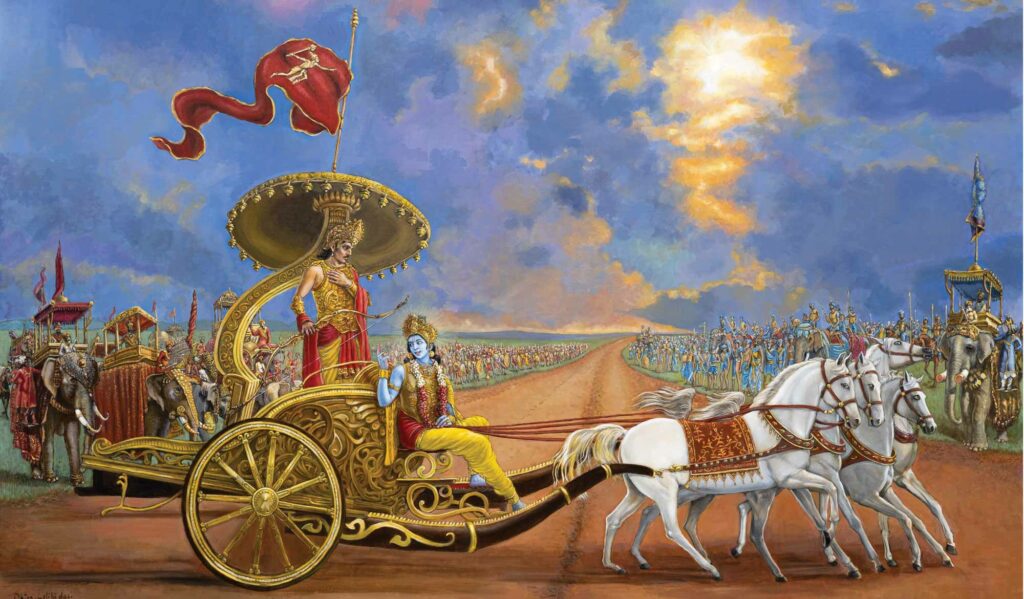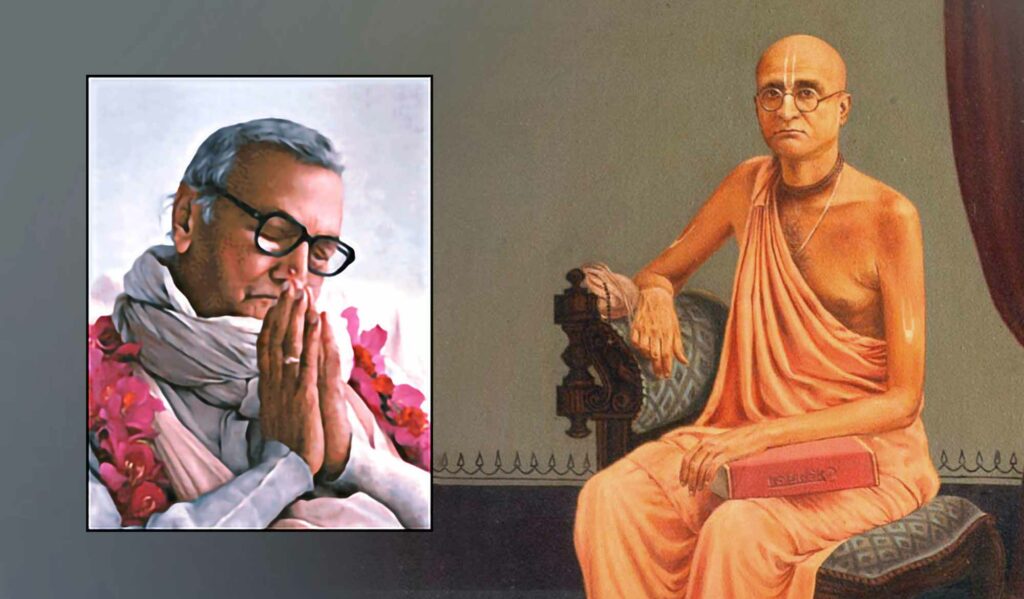Overview
In "Frogs in the Well of Prejudice' Kalki Dāsa shares a recent experience he had in Śrī Vṛndāvana-dhāma and asks the unusual question, “Are we humans, or are we frogs?” Are we doomed to continuously return to our deep, dark mental wells of prejudice, or is there a way out?
Five frogs in a well, four walls framed
Mental case, shallow water, living in the brain
Every day insects come and feed us till we’re full
Dimmed light up above, starving little souls
Four frogs in a bucket going on a trip
Destination greener pastures “tighten up the grip”
How big? how wide? How far away?
“Stretch the throat, you can do it!” Rear legs splayed.
One frog in a well feeling kind of lonely
Thinking if his friends came back he wouldn’t be the only
“Worry not! We’re coming back!” His buddies shout and tell
“The world beyond these four walls is scary as hell!”
It’s not uncommon to find frogs living in tight spaces and in almost complete darkness. The frog in the well is sheltered by his environment, and so cannot fathom anything beyond its boundaries. This classic example in Vedic philosophy serves to illustrate how our own limited experiences form the walls of our mental conception.
I recently had my own personal experience of this in Vṛndāvana after we removed a tarpaulin over a large well that was recently dug. We looked down ten feet to find five fully grown frogs in a few inches of water. After climbing into the well we managed to gather four of the frogs into a closed container, but the fifth one proved too elusive to capture. After releasing the frogs into a nearby marsh I was confident they would be satisfied in their new environment. I came back only a half an hour later to find that all the frogs were back in the well!
The reason why the frogs returned was most likely due to fear. Outside of the well there are numerous predators, dangerous elements, and much uncertainty, but in the well there are only five frogs and a constant supply of food.
The impression then came to me was that the well, filled with shallow water, nicely represented the mind, and the five frogs, the five senses. Our brains and bodies are resting in water, and the limits of our experience form the walls of our mental prejudice.
It has been proven that like the tides on the ocean, the water in our bodies also fluctuates with the moon. In this way ancient seers identified the moon with the mind, pulling on the fluids of our body and influencing us to act under different modes of material nature. We are told that during Ekādaśī, the eleventh day of the moon, we are especially vulnerable to that influence.
Here we find that on the Ekādaśī day we feel more aggressive energy within us. So to keep the balance, fasting has been recommended in the scriptures, superfluous enjoying mood springs from within on the day of Ekādaśī by the movement that is attributed by the moon and the vāta, all these things. Wherever there is water it develops. The rasa, the juice in the body develops to a substantial extent and excites the persons in the enjoyment. (Śrīla Śrīdhara Deva Gosvāmī, February 19th 1982)
As the tongue is the most voracious sense to tame, it often conspires with the other senses in order to fulfil its aims. Not only was the fifth frog the hardest to catch, but it almost seemed like he was able to call the other frogs back. Similarly if we are unable to control our tongues through taking bhāgavata-prasādam and following regulations like Ekādaśī, the many tastes and pleasures we once knew will call us back to enjoy them.
Understanding the nature of both the transcendental and material worlds, great ācāryas give a path to students how to remain aloof from all things anti-spiritual, and develop a genuine taste for the truth. One of the first steps given by our ācāryas is to leave behind the mental baggage of our previous experience and accept a new pair of eyes.
When the celebrated Vaiṣṇava Sadānanda Swami met his guru, Śrīla Bhaktisiddhānta Sarasvatī Ṭhākura Prabhupāda, he was given that very instruction,
On the second day after my arrival here, my Gurudeva told me: “The first thing you have to do is to collect all what you learned, read, excerpted, felt, know. Put it in a big bag and throw it into the sea where the sea is deepest and start anew. (Sādananda Swami, letter to Walther Eidlitz 20.9.55)
Through this process of surrender we become qualified to see things as they are, through the lens of guru, sādhu, and śāstra. This point must be constantly emphasised, and repeated throughout the course of our journey in order to insure what we are receiving is from a divine source and not our minds.
Unfortunately, it seems that even after coming to the feet of such personalities it happens that our saṁskāras (previous tendencies) return to drag us back. This happens especially after great ācāryas withdraw from the physical plane, and the disciple is unable to find his spiritual master in living essence. We see this manifest in the form of society consciousness, accompanied by a fearful condition.
Team names such as (insert institution/āśrama name here) come to wall off the individual from the threat of perceived outsiders. The inclusivity necessary for welcoming newcomers is thrown to the breeze in preference for persons in the society who don’t rock the boat. Like the frog, persons trapped in the society try to call out to former associates to return to the echo chamber so that everyone can live together in a state of neutrality.
What to speak of awkward social relations, our mental prejudice will even keep us from developing real faith in māha-prasādam, the Vaiṣṇava, and the holy dhāma. This is because although resembling ordinary food, people, and places, the truth behind these divine subjects can only be experienced through the agency of śraddhā (divine faith), and not our mental conception. Śrīla Śrīdhara Mahārāja explains further:
The function of the mind is speculation (mano-dharma); that is its nature. It has nothing to do with truth. Mental speculation is drawn from the material world, the world of misconception. The mind is full of misconception (avāṅ-manasā gocaraḥ). It cannot reach the stage of feeling or perceiving the truth proper. It is only related to mundane things in the plane of exploitation.
The mind cannot be pure, just as a fossil cannot produce life. Similarly, the mind cannot produce śraddhā, divine faith. Śraddhā is original and fundamental. When the Supreme Lord appears in the heart, the mind vanishes. Reality is just the opposite of speculation. Darkness cannot produce light; light comes and darkness vanishes. Truth appears when pure consciousness emerges and mental speculation vanishes. The mind is concerned with misconception. It is an element of the aparā-śakti, the inferior potency. That potency is both subtle and gross. Earth, water, fire, air, and ether are gross manifestations; mind intelligence and ego are subtle. But they’re all material.
The soul is transcendental. Svarūpa-śakti, or the Lord’s personal potency, bhajana, or divine service, and Goloka-Vaikuṇṭha are all supra-mundane and transcendental. They are beyond the soul, not on the denser realm where the mind is located. Properly speaking, purity or impurity cannot be attributed to the mind. If we do everything will be misunderstood. The mind emerges from the false ego and it is imbued with the tendency to exploit. (‘Follow The Angels’)
Who will save us from our minds?! It is of course our positive and progressive association. Those who inspire us to search for our gurus and continue to serve them wholeheartedly, those who request us to read their words and hear their lectures with utmost attention. Our śikṣā-gurus come to our relief, reminding us about our duty and giving us courage to face the uncertainty that lies ahead.
What the frogs taught me is that it’s easy to slip into a mental experience of spiritual life. Just as the frog’s experience of the outside vanished as soon as they returned to the well, our experience will also disappear so long as it is not experienced in the plane of the heart. We will be deceived, and we may deceive others also.
We therefore pray to our Guardians to protect us from our mental prejudice and bless us with the śraddhā needed to bow our heads, and catch divinity wherever it is flowing.
Trust no future, however pleasant!
Let the dead past bury its dead!
Act,— act in the living present!
Heart within, and God overhead!
(Henry Wadsworth Longfellow)
Related Articles & Books
- Vaiṣṇava Nindā by Śrīla Bhaktivinoda Ṭhākura
- A Devotee is Merciful (Sajjana – Kṛpālu) by Śrīla Bhaktisiddhānta Sarasvatī Ṭhākura
- A Devotee Does Not Engage in Violence (Sajjana – Akṛta-droha) by Śrīla Bhaktisiddhānta Sarasvatī Ṭhākura
- A Devotee is the Epitome of Truth (Sajjana – Satya-sāra) by Śrīla Bhaktisiddhānta Sarasvatī Thākura
- Śiva-tattva & the Position of Lord Śiva by Śrīla B.R. Śrīdhara Mahārāja
- Oh Bābā! Bolacche-re! by Śrīla B.R. Śrīdhara Mahārāja
- Problems and Solutions by Śrīla B.R. Śrīdhara Mahārāja
- The Highest Attainment and Present Adjustment by Śrīla B.R. Śrīdhara Mahārāja
- Āgun Jvālbe (Light the Fire!) by Śrīla B.R. Śrīdhara Mahārāja
- Dharma and the Modern World by Śrīla A.C. Bhaktivedānta Swami Prabhupāda
- Faith Confirms the Absolute by Śrīla B.G. Narasiṅgha Mahārāja
- Go Deeper! by Śrīla B.G. Narasiṅgha Mahārāja
- To Be a Servant by Śrīla B.G. Narasiṅgha Mahārāja
- Harmony – Real and Apparent by Swami B.V. Giri
- The Definition of Faith by Gaura Gopāla Dāsa
- Ātma Samīkṣā – The Value of Introspection by Kalki Dāsa
- Frogs in the Well of Prejudice by Kalki Dāsa
Further Reading
- Śraddhā (Faith) – Quotes by Bhaktivinoda Thakura
- Śraddhā and Śaraṇāgati by Śrīla Bhaktivinoda Ṭhākura
- The Association of Sādhus by Śrīla Bhaktivinoda Ṭhākura
- Epilogue to Śrī Kṛṣṇa Karṇāmṛta by Śrīla Bhaktivinoda Ṭhākura
- Prīti (Love) by Śrīla Bhaktivinoda Ṭhākura
- A Dispute Concerning Mahāprasāda by Śrīla Bhaktivinoda Ṭhākura
- Śraddhā by Śrīla Bhaktivinoda Ṭhākura
- Materialistic Association by Śrīla Bhaktivinoda Ṭhākura
- Dispelling Doubts by Śrīla Bhaktivinoda Ṭhākura
- The Enemy by Śrīla Bhaktivinoda Ṭhākura
- A Critique of the book ‘Vanamālā’ by Śrīla Bhaktivinoda Ṭhākura
- Kali by Śrīla Bhaktivinoda Ṭhākura
- Offences Against Bhakti by Śrīla Bhaktivinoda Ṭhākura
- Kārttika-vrata by Śrīla Bhaktivinoda Ṭhākura
- Violence and Mercy by Śrīla Bhaktivinoda Ṭhākura
- Abandoning Bad Association by Śrīla Bhaktivinoda Ṭhākura
- Sad-guṇa and Bhakti by Śrīla Bhaktivinoda Ṭhākura
- The Process of Initiation by Śrīla Bhaktivinoda Ṭhākura
- Dainya (Humility) by Śrīla Bhaktivinoda Ṭhākura
- Vaiṣṇava Nindā (Offences to Devotees) by Śrīla Bhaktivinoda Ṭhākura
Pilgrimage with Swami Narasiṅgha – Part 7: Keśī Ghāṭa
Continuing with our pilgrimage series, this week Śrīla Narasiṅgha Mahārāja takes us to Keśī Ghāṭā where he tells us about Madhumaṅgala’s meeting with the Keśī demon, what Keśī represents, and how Śrīla Prabhupāda almost acquired Keśī Ghāṭa. Mahārāja also narrates his own experience. This article has been adapted from a number of talks and articles by Narasiṅgha Mahārāja.
Prema Dhāma Deva Stotram with the Narasiṅgha Sevaka Commentary – Verses 61-65
In verses 61 to 65 of 'Prema Dhāma Deva Stotram', Śrīla Śrīdhara Mahārāja narrates the pastime of Śrī Caitanya at Caṭaka Parvata In Purī and explains how the scriptures produced by Brahmā and Śiva are ultimately searching for the personality of Mahāprabhu who is merciful too all jīvas, no matter what their social position.
Prabhupāda Śrīla Sarasvatī Ṭhākura’s Visit to Ayodhyā
With the forthcoming observance of Śrī Rāma Navamī, we present 'Prabhupāda Śrīla Sarasvatī Ṭhākura’s Visit to Ayodhyā' written by Śrīla Bhaktisiddhānta Sarasvatī Ṭhākura Prabhupāda from The Gaudīyā magazine, Vol 3. Issue 21/ In December 1924, after visiting Benares and Prāyāga, Sarasvatī Ṭhākura visited the birth-site of Śrī Rāmācandra in Ayodhyā.
Śaraṇāgati – The Only Path to Auspiciousness
In this article, 'Śaraṇāgati - The Only Path to Auspiciousness', Dhīra Lalitā Dāsī analyses the process of śaraṇāgati (surrender) beginning with śraddhā (faith). She also discusses the role of śāstra and the Vaiṣṇava in connection with surrender.
Pilgrimage with Swami Narasiṅgha – Part 7: Keśī Ghāṭa
Continuing with our pilgrimage series, this week Śrīla Narasiṅgha Mahārāja takes us to Keśī Ghāṭā where he tells us about Madhumaṅgala’s meeting with the Keśī demon, what Keśī represents, and how Śrīla Prabhupāda almost acquired Keśī Ghāṭa. Mahārāja also narrates his own experience. This article has been adapted from a number of talks and articles by Narasiṅgha Mahārāja.
Prema Dhāma Deva Stotram with the Narasiṅgha Sevaka Commentary – Verses 61-65
In verses 61 to 65 of 'Prema Dhāma Deva Stotram', Śrīla Śrīdhara Mahārāja narrates the pastime of Śrī Caitanya at Caṭaka Parvata In Purī and explains how the scriptures produced by Brahmā and Śiva are ultimately searching for the personality of Mahāprabhu who is merciful too all jīvas, no matter what their social position.
Prabhupāda Śrīla Sarasvatī Ṭhākura’s Visit to Ayodhyā
With the forthcoming observance of Śrī Rāma Navamī, we present 'Prabhupāda Śrīla Sarasvatī Ṭhākura’s Visit to Ayodhyā' written by Śrīla Bhaktisiddhānta Sarasvatī Ṭhākura Prabhupāda from The Gaudīyā magazine, Vol 3. Issue 21/ In December 1924, after visiting Benares and Prāyāga, Sarasvatī Ṭhākura visited the birth-site of Śrī Rāmācandra in Ayodhyā.
Śaraṇāgati – The Only Path to Auspiciousness
In this article, 'Śaraṇāgati - The Only Path to Auspiciousness', Dhīra Lalitā Dāsī analyses the process of śaraṇāgati (surrender) beginning with śraddhā (faith). She also discusses the role of śāstra and the Vaiṣṇava in connection with surrender.








